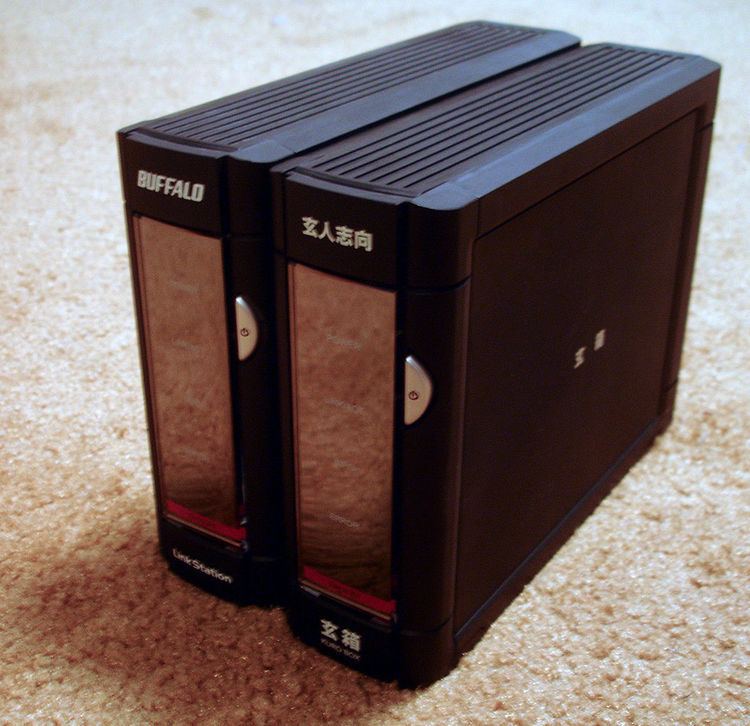Operating system Connectivity 100BASE-TX, 1000BASE-T | ||
 | ||
Type Network-attached storage | ||
The Buffalo network-attached storage series are network-attached storage devices.
Contents
They can be modified into miniature general purpose Linux-based computers. The LinkStation and TeraStation are intended for the general public, while the Kuro Box is intended for expert hackers as a cheap platform for Linux development.
These devices have undergone various improvements since they were first produced. For example, the first generation of this device had a 100BASE-TX network adapter using a Parallel ATA hard drive. The current version has a 1000BASE-T-capable connection and uses the Serial ATA interface. Older generations of the device used PowerPC and MIPS processors, while the latest version of the device uses an ARM architecture processor.
LinkStation
The LinkStation is a PowerPC, MIPS or ARM based network attached storage appliance sold in North America, Europe and Japan, that is significantly notable among the Linux community both in Japan and in the US/Europe for being "hackable" into a generic Linux appliance and made to do tasks other than the file storage task for which it was designed. The Linkstation has Ethernet, USB, and serial ports, but does not have a video output. It is made by Buffalo Technology a division of Melco. Produced in Japan, as of 2006 it is also available at American retailers such as Best Buy and CompUSA, as well as in Europe.
Kuro Box
The Kuro Box is the name for a series of PowerPC and ARM processor based computers intended for use as a Network-attached storage device. The original Kuro Box was made from spare hardware components the manufacturer had from the Linkstation. Recent versions of the Kuro Box use later Linkstation hardware or hardware very similar to that of the Linkstation. All Kuro Box versions are provided without a hard drive. The case has the same physical dimensions and shape as the corresponding LinkStation, but it is black in color and has the Japanese symbols for "Kuro Box" (玄箱, meaning "a box operated by an expert with esoteric knowledge") in silver lettering on the side panel. The name is also a pun because kuro (different kanji: 黒) also means 'black'.
TeraStation
Since January 2012, the TeraStation uses LIO for its iSCSI target.
LinkStation
As the device runs on Linux, and included changes to the Linux source code, Buffalo was required to release their modified versions of Source code as per the terms of the GNU General Public License. Due to the availability of source code and the relatively low cost of the device, there are several community projects centered around it. There are two main replacement firmwares available for the device: the first is OpenLink which is based on the official Buffalo firmware with some improvements and features added. The other is FreeLink, which is a Debian distribution.
Kurobox
The product was designed by the manufacturer to accept a user-supplied Linux distribution. Several including a Kurobox-specific distribution called Sylver, Debian, Gentoo Linux, and Fedora Core have been ported to it by various user groups in both the US/Europe, and Japan.
TeraStation
Like the LinkStation the device runs its own version of Linux. Debian and Gentoo Linux distributions and NetBSD are reported to have been ported to it.
Uses
The device in various iterations ships with its own Universal Plug and Play protocol for distribution of multimedia stored on the device. It can also be configured as a variety of different media servers TwonkyVision Media server, a SlimServer/SqueezeCenter server, an iTunes server using the Digital Audio Access Protocol, a Samba server, an LIO iSCSI target, MLDonkey client, as well as a Network File System server for Posix-based systems. For use as a backup server, it can be modified to use it with Rsync to back up or synchronize data from one or many computers in the network pushing their data, or even having the LinkStation pulling the data from remote servers—beside the use of the Buffalo-provided backup software for Windows. It has also found use in a number of other ways, notably through its USB interface which comes configured as a Print server but can also use the Common Unix Printing System to act as such for a USB Printer. Users have managed to get it to use a number of other USB devices with the version 2.6 Linux kernel's enhanced USB support. Additionally, because the Apache HTTP Server software is already installed for the purpose of providing the Buffalo configuration screens, the device is easily converted to be a lightweight web server (with the Buffalo content deleted) and then can serve any content of the operator's choice.
